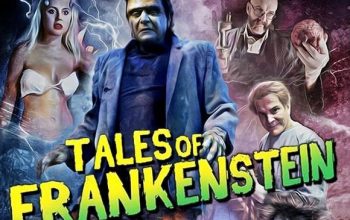Frankenstein: Day of the Beast – 2011
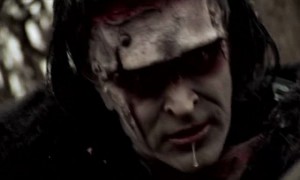
I’ll just race through the synopsis of Frankenstein: Day of the Beast quickly. This is because, while there’s lots of running and screaming in this movie, not a lot actually happens. What does happen is pretty icky. Just thought I should warn you. On the other hand, it does give a convenient — if awful — jumping-on point to talk about the character of Elizabeth Lavenza.
Frankenstein and some soldiers are tracking the Monster through the snow. The Monster is seen by the daughter of the old blind man. We have a little look into their family dramas, then the Monster kills them all, the daughter last of all. We see the dying daughter being stitched back together in a darkened room.
Shift of scenery to an island on a lake. Frankenstein is going to marry Elizabeth, but is worried that the Monster is coming. So he’s taken a priest to an abandoned (but still consecrated?) church, along with a posse of gunmen to protect them. The Monster arrives and kills everyone one by one in a variety of ‘gruesome’ ways.
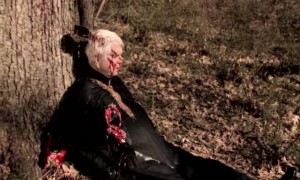
Frankenstein flashes back to the creation of the Monster. This kills some screen time. Back in the present, a dwindling number of survivors fight amongst themselves as the Monster continues to kill them. Frankenstein suggests that his creature’s soulless body is possessed by a demon, and reveals that it was the Monster who sewed the blind man’s daughter back together as a message that it wants a mate. Elizabeth gets a few scenes where she gets to do cool stuff (which is better than how her character is usually handled) and then the Monster rapes her (which is much, much worse). Elizabeth shoots herself. Frankenstein tries to resurrect her. She kills him and goes off with the Monster.
So what can I say… It’s nicely filmed?
I mean, the shots are nicely framed, scenery is well incorporated into the composition and there are a couple of interesting shots. I won’t say that the cinematography is memorable, but it’s competent, even bordering on talented.
The rest… Did I mention that this is a low budget movie? I believe that it was crowdfunded, in fact. Now, recent advances in film making have been a boon for low budget horror in some ways. Basically, digital filmmaking, editing and online distribution make it much easier for amateurs and semi-pros to get their work made and out before the public.
On the other hand, the high resolution of digital cameras means that special effects shots that people would have gotten away with on actual film look as fake as hell now. Scenes of bloody carnage that might have worked in the 1970s or ’80s just look flat-out silly that you can see everything clearly.
But that’s just niggling. There are much worse elements to be found. The acting is barely at high school drama class standard, the sound effects are laughable, most of the action is silly. Huge chunks of time-wasting crap are based on a tired riff on the ‘too busy arguing to survive’ structure that was clever when Night of the Living Dead did it in the late ’60s, but yawn-inducing today.
But, yeah. It’s a crappy low-budget horror film, so what do I expect?
No, the problem comes from the treatment of Elizabeth. Early in the movie she’s treated as kind of tough. She pulls guns on people, she goes exploring tunnels, and when anyone calls her ‘Mrs Frankenstein’, she insists on ‘Elizabeth’.
Elizabeth in the novel is a very different character. It has often been said that in Frankenstein the male characters are morally complex and the female characters are boringly saintly. Of course, most of the novel is narrated by Victor Frankenstein. It’s possible that Mary Shelley meant to show how Frankenstein views the women in his life, rather than how they actually were. Even so, the only picture the novel has given us of Elizabeth is a kindly, passive soul.
This has allowed filmmakers to basically do what they like with this blank-slate character. She’s lively and proactive in 1931’s Frankenstein, bland in Curse of Frankenstein, unsympathetic in Frankenstein: the True Story, angry in Flesh for Frankenstein* and so on. The only similarity between her different incarnations is that she tries to stop Frankenstein in his work — by telling him to stop. She never taking the obvious move of changing her name and getting as far away as possible.

In the novel, Elizabeth is tied to some ideas that usually get left out of film versions. The ideas that Day of the Beast is playing with here are nasty, but not completely invalid. In the novel, the Monster wants a mate. Frankenstein is terrified that his creation will breed a race of monsters. This same fear of being outbred and outnumbered I would suggest arises from a number of (mostly) unconscious prejudices, and can also be seen in Dracula, the Alien movies, and most notably in the zombie genre.
But Frankenstein movies usually skip this racial paranoia. Or at least, the Frankenstein movies that we call Frankenstein movies do. The idea of artificial beings growing in number and taking over is still present in our horror, but tend to involve robots rather than shambling patchwork corpses. Part of the reason for this is that the Monster never actually becomes the father of a new race in Mary Shelley’s Frankenstein. It’s something that Victor fears, but which never comes about.
And it doesn’t come about because Victor never completes the Bride. He destroys his work half finished. The Monster promises to take his revenge on Frankenstein on Frankenstein’s wedding night. Frankenstein believes that the Monster will kill him, but instead it is Elizabeth who is murdered — a proxy victim in a fight between men.
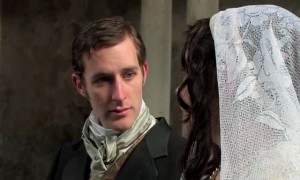
There’s a lot more weird sex/sexually adjacent stuff in Frankenstein, which is overshadowed by its central conceit of asexual reproduction. So, as I say, the Day of the Beast is playing with actual ideas from the novel when it has the Monster rape Elizabeth. I can’t say I like the idea—not even slightly—but I see where the filmmakers are coming from.
But the idea is used all wrong. This element and the whole ‘monster is possessed’ idea are the only really new ideas this version has to add to the Frankenstein myth, and neither of them are given enough weight. The ‘possession’ thing is mentioned by Frankenstein and backed up by nothing. And the rape is saved for a third act shock, immediately followed by Elizabeth’s suicide — as if to actively prevent examination the possible consequences of the act. A questionable story choice is immediately shorn of meaning.
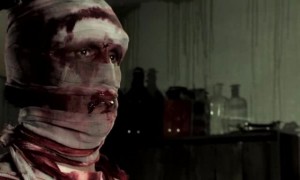
And the douchey smile the Monster gives Frankenstein afterwards is just… ugh. Come back third act of Kenneth Branagh’s Frankenstein. All is forgiven.
So that’s Frankenstein: Day of the Beast. Rated 3.6 on IMDB, which doesn’t always get it right, but this time is pretty fair. Could have been a silly, mildly enjoyable gorefest, but insisted on leaving a bad taste in the mouth.
* Aka Andy Warhol’s Frankenstein. I’ve been quite harsh on Frankenstein: Day of the Beast but honestly, I like it a whole lot better than Flesh For Frankenstein, which I’ll get around to reviewing one day. It’s just as gratuitously nasty as Day of the Beast, but at least Day of the Beast isn’t as unbearably pretentious.



